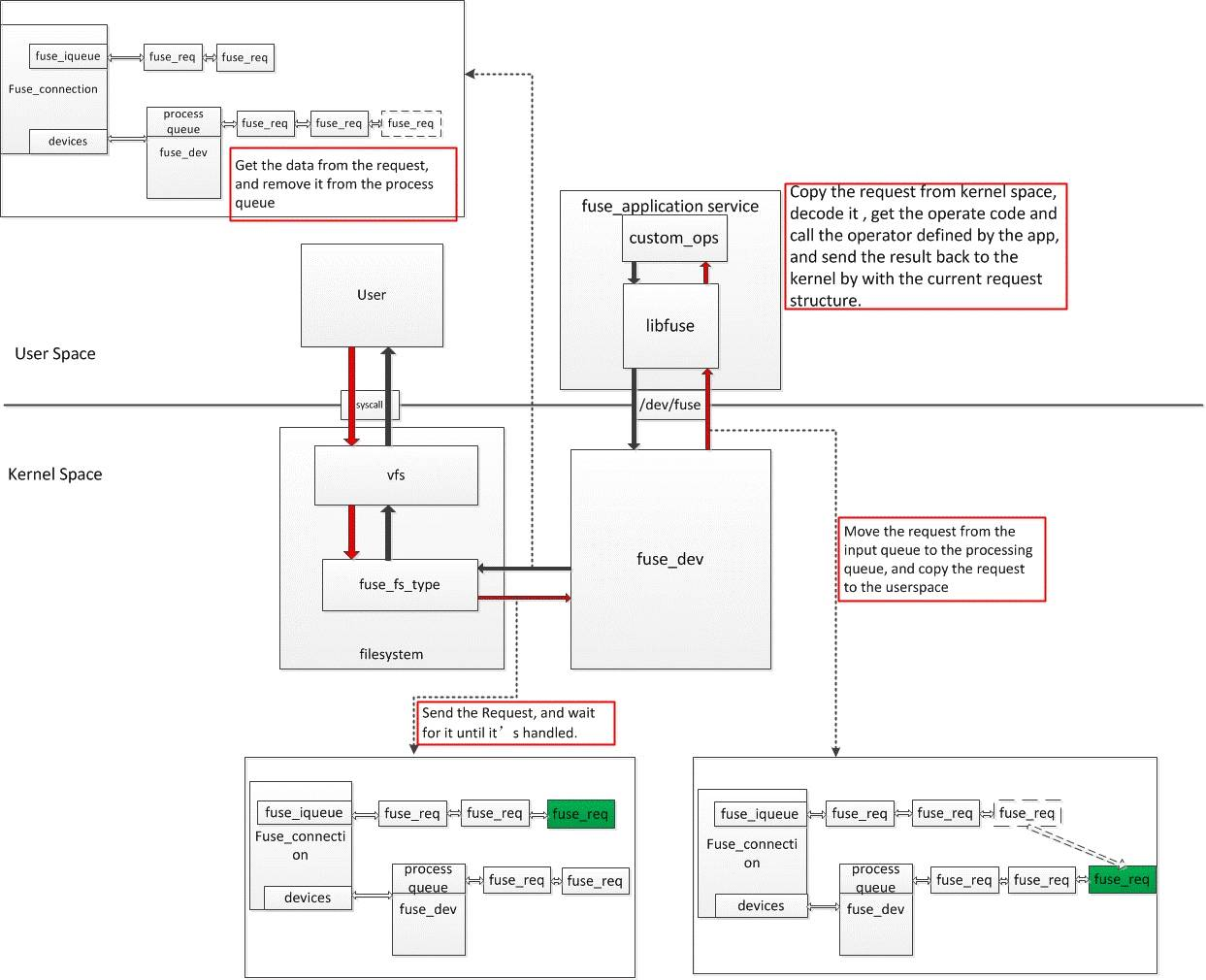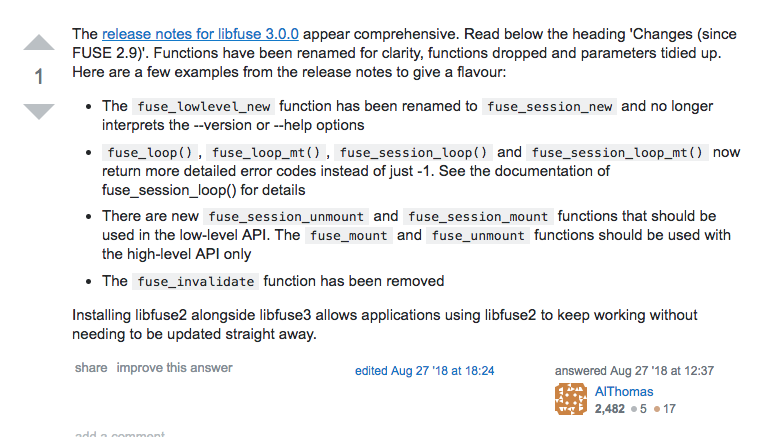FUSE 用户空间文件系统 (Filesystem in Userspace)
关于Fuse文件系统:
FUSE (Filesystem in Userspace) is an interface for userspace programs to export a filesystem to the Linux kernel. The FUSE project consists of two components: the fuse kernel module (maintained in the regular kernel repositories) and the libfuseuserspace library (maintained in this repository). libfuse provides the reference implementation for communicating with the FUSE kernel module.
A FUSE file system is typically implemented as a standalone application that links with libfuse. libfuse provides functions to mount the file system, unmount it, read requests from the kernel, and send responses back. libfuse offers two APIs: a "high-level", synchronous API, and a "low-level" asynchronous API. In both cases, incoming requests from the kernel are passed to the main program using callbacks. When using the high-level API, the callbacks may work with file names and paths instead of inodes, and processing of a request finishes when the callback function returns. When using the low-level API, the callbacks must work with inodes and responses must be sent explicitly using a separate set of API functions.
FUSE 宏观调用:
以open为例,整个调用的过程如下:
1- 用户态app调用glibc open接口,触发sys_open系统调用。
2- sys_open 调用fuse中inode节点定义的open方法。
3- inode中open生成一个request消息,并通过/dev/fuse发送request消息到用户态libfuse。
4- Libfuse调用fuse_application用户自定义的open的方法,并将返回值通过/dev/fuse通知给内核。
5- 内核收到request消息的处理完成的唤醒,并将结果放回给VFS系统调用结果。
6- 用户态app收到open的返回结果。

FUSE 包含两个大的发行版本:fuse2 和 fuse3 ,那么fuse2 和 fuse3之间有什么区别呢?(What exactly is the difference between fuse2 and fuse3?)

FUSE 安装
FUSE 安装分为两种方式,一种是 编译安装,另外一张是通过包管理软件(YUM)进行安装。编译安装按照官方教程安装即可。
我使用的操作系统是 Fedora 29, 所以尝试使用yum进行安装:
首先使用rpm 命令查一下当前系统是否已经安装了fuse:
[root@docker 4.19.-.fc29.x86_64]# rpm -aq | grep fuse
fuse-common-3.2.-.fc29.x86_64
fuse-2.9.-.fc29.x86_64
fuse-libs-2.9.-.fc29.x86_64
glusterfs-fuse-5.2-.fc29.x86_64
gvfs-fuse-1.38.-.fc29.x86_64
zfs-fuse-0.7.2.2-.fc27.x86_64
可见已经安装好了,当前系统中使用的是fuse的2.9.7版本,并且是有相应的库。所以算是已经安装好了。如果系统中没有上述安装包,可以使用yum进行安装。
[root@docker 4.19.-.fc29.x86_64]# yum search fuse
Last metadata expiration check: :: ago on Sat Jan :: PM CST.
============================================================================ Summary & Name Matched: fuse ============================================================================
fuse.x86_64 : File System in Userspace (FUSE) v2 utilities
fuse.x86_64 : File System in Userspace (FUSE) v2 utilities
fuse-libs.x86_64 : File System in Userspace (FUSE) v2 libraries
fuse-libs.i686 : File System in Userspace (FUSE) v2 libraries
fuse-libs.x86_64 : File System in Userspace (FUSE) v2 libraries
fuse3-libs.i686 : File System in Userspace (FUSE) v3 libraries
fuse3-libs.x86_64 : File System in Userspace (FUSE) v3 libraries
fuse-devel.i686 : File System in Userspace (FUSE) v2 devel files
fuse-devel.x86_64 : File System in Userspace (FUSE) v2 devel files
fuse3-devel.i686 : File System in Userspace (FUSE) v3 devel files
fuse3-devel.x86_64 : File System in Userspace (FUSE) v3 devel files
fuse-common.x86_64 : Common files for File System in Userspace (FUSE) v2 and v3
fuse-common.x86_64 : Common files for File System in Userspace (FUSE) v2 and v3
通过自己的需求,安装对应版本的安装包:fuse-common.x86_64 这个软件包在v2和v3两个版本中都能进行使用。当然你也可以查看包里的内容,进一步了解fuse的组成。
fuse 的内核模块也已经内置到操作系统内核之中了:
[root@docker fuse]# pwd
/lib/modules/4.19.-.fc29.x86_64/kernel/fs/fuse
[root@docker fuse]# ls
fuse.ko.xz
为了能够开发属于自己的文件系统,还要安装fuse开发包:
fuse-devel.x86_64 : File System in Userspace (FUSE) v2 devel files
Name : fuse-devel
Version : 2.9.
Release : .fc29
Arch : x86_64
Size : k
Source : fuse-2.9.-.fc29.src.rpm
Repo : fedora
Summary : File System in Userspace (FUSE) v2 devel files
URL : http://fuse.sf.net
License : LGPLv2+
Description : With FUSE it is possible to implement a fully functional filesystem in a
: userspace program. This package contains development files (headers,
: pgk-config) to develop FUSE v2 based applications/filesystems.
我们从包描述可以看到,包中包括了一些开发所需要一些头文件, 动态链接库(.so),pgk-config 文件等。
FUSE 简单使用(DEMO)
high-level API:
/*
FUSE: Filesystem in Userspace
Copyright (C) 2001-2007 Miklos Szeredi <miklos@szeredi.hu> This program can be distributed under the terms of the GNU GPL.
See the file COPYING. gcc -Wall hello.c `pkg-config fuse --cflags --libs` -o hello
*/ #define FUSE_USE_VERSION 26 //先定义, fuse.h中有判断 #include <fuse.h>
#include <stdio.h>
#include <string.h>
#include <errno.h>
#include <fcntl.h> static const char *hello_str = "Hello World!\n";
static const char *hello_path = "/hello"; // 与函数stat()类似,用于得到文件属性,并将其存入到结构体struct stat当中 struct stat *stbuf
static int hello_getattr(const char *path, struct stat *stbuf)
{
int res = ; memset(stbuf, , sizeof(struct stat)); // 使用memset进行初始化结构体
if (strcmp(path, "/") == ) {
stbuf->st_mode = S_IFDIR | ; // S_IFDIR 用于说明 / 为目录
stbuf->st_nlink = ;
} else if (strcmp(path, hello_path) == ) {
stbuf->st_mode = S_IFREG | ; // S_IFREG 用于说明/hello 为常规文件
stbuf->st_nlink = ;
stbuf->st_size = strlen(hello_str); // 设置文件长度为hello_str的长度
} else
res = -ENOENT; // 返回错误信息,没有该文件或者目录 return res; // 成功执行的时候,此函数返回值为 0
} // 该函数用于读取目录中的内容,并在/目录下增加了. .. hello 三个目录项
static int hello_readdir(const char *path, void *buf, fuse_fill_dir_t filler,
off_t offset, struct fuse_file_info *fi)
{
(void) offset;
(void) fi; if (strcmp(path, "/") != )
return -ENOENT; /* fill, 其作用是在readdir函数中增加一个目录项
typedef int (*fuse_fill_dir_t) (void *buf, const char *name,
const struct stat *stbuf, off_t off);
*/ filler(buf, ".", NULL, );
filler(buf, "..", NULL, );
filler(buf, hello_path + , NULL, ); //指针+1(/hello), 即增加 hello 目录项,去掉前面的'/' return ;
} // 打开文件函数
static int hello_open(const char *path, struct fuse_file_info *fi)
{
if (strcmp(path, hello_path) != )
return -ENOENT; if ((fi->flags & ) != O_RDONLY)
return -EACCES; return ;
} // 读文件函数
static int hello_read(const char *path, char *buf, size_t size, off_t offset,
struct fuse_file_info *fi)
{
size_t len;
(void) fi;
if(strcmp(path, hello_path) != )
return -ENOENT; len = strlen(hello_str);
if (offset < len) {
if (offset + size > len)
size = len - offset;
memcpy(buf, hello_str + offset, size);
} else
size = ; return size;
} // 注册自定义函数
static struct fuse_operations hello_oper = {
.getattr = hello_getattr,
.readdir = hello_readdir,
.open = hello_open,
.read = hello_read, // 读文件函数
}; // 调用 fuse_main , 把控制权交给了fuse
int main(int argc, char *argv[])
{
return fuse_main(argc, argv, &hello_oper, NULL);
}
执行:
挂载:
[root@docker example]# mkdir /tmp/fuse
[root@docker fuse-example]# ./hello /tmp/fuse/
[root@docker fuse-example]# cd /tmp/fuse/
读取文件属性:
[root@docker fuse]# ll
total
-r--r--r--. root root Jan hello
读取目录属性:
[root@docker tmp]# ll /tmp/
total
drwxr-xr-x. root root Jan fuse 卸载:
[root@docker tmp]# fusermount -u /tmp/fuse
[root@docker tmp]# ls /tmp/fuse/
当然你也可以修改代码,对fuse的特性进一步尝试。
low-level API: low-level api 相对于 high-level api 来说,有更好的自由度;high-level相对于 low-level api 则有更简单的api使用,如果阅读过fuse源码过后,使用low-level api将使得可控性更强。下面是hello.c 的low-level api 版本
/*
FUSE: Filesystem in Userspace
Copyright (C) 2001-2007 Miklos Szeredi <miklos@szeredi.hu> This program can be distributed under the terms of the GNU GPL.
See the file COPYING. gcc -Wall hello_ll.c `pkg-config fuse --cflags --libs` -o hello_ll
*/ #define FUSE_USE_VERSION 26 #include <fuse_lowlevel.h>
#include <stdio.h>
#include <stdlib.h>
#include <string.h>
#include <errno.h>
#include <fcntl.h>
#include <unistd.h>
#include <assert.h> static const char *hello_str = "Hello World!\n";
static const char *hello_name = "hello"; static int hello_stat(fuse_ino_t ino, struct stat *stbuf)
{
stbuf->st_ino = ino;
switch (ino) {
case :
stbuf->st_mode = S_IFDIR | ;
stbuf->st_nlink = ;
break; case :
stbuf->st_mode = S_IFREG | ;
stbuf->st_nlink = ;
stbuf->st_size = strlen(hello_str);
break; default:
return -;
}
return ;
} static void hello_ll_getattr(fuse_req_t req, fuse_ino_t ino,
struct fuse_file_info *fi)
{
struct stat stbuf; (void) fi; memset(&stbuf, , sizeof(stbuf));
if (hello_stat(ino, &stbuf) == -)
fuse_reply_err(req, ENOENT);
else
fuse_reply_attr(req, &stbuf, 1.0);
} static void hello_ll_lookup(fuse_req_t req, fuse_ino_t parent, const char *name)
{
struct fuse_entry_param e; if (parent != || strcmp(name, hello_name) != )
fuse_reply_err(req, ENOENT);
else {
memset(&e, , sizeof(e));
e.ino = ;
e.attr_timeout = 1.0;
e.entry_timeout = 1.0;
hello_stat(e.ino, &e.attr); fuse_reply_entry(req, &e);
}
} struct dirbuf {
char *p;
size_t size;
}; static void dirbuf_add(fuse_req_t req, struct dirbuf *b, const char *name,
fuse_ino_t ino)
{
struct stat stbuf;
size_t oldsize = b->size;
b->size += fuse_add_direntry(req, NULL, , name, NULL, );
b->p = (char *) realloc(b->p, b->size);
memset(&stbuf, , sizeof(stbuf));
stbuf.st_ino = ino;
fuse_add_direntry(req, b->p + oldsize, b->size - oldsize, name, &stbuf,
b->size);
} #define min(x, y) ((x) < (y) ? (x) : (y)) static int reply_buf_limited(fuse_req_t req, const char *buf, size_t bufsize,
off_t off, size_t maxsize)
{
if (off < bufsize)
return fuse_reply_buf(req, buf + off,
min(bufsize - off, maxsize));
else
return fuse_reply_buf(req, NULL, );
} // 读取文件夹目录
static void hello_ll_readdir(fuse_req_t req, fuse_ino_t ino, size_t size,
off_t off, struct fuse_file_info *fi)
{
(void) fi; if (ino != )
fuse_reply_err(req, ENOTDIR);
else {
struct dirbuf b; memset(&b, , sizeof(b));
dirbuf_add(req, &b, ".", );
dirbuf_add(req, &b, "..", );
dirbuf_add(req, &b, hello_name, );
reply_buf_limited(req, b.p, b.size, off, size);
free(b.p);
}
} // 处理打开操作函数,检查权限
static void hello_ll_open(fuse_req_t req, fuse_ino_t ino,
struct fuse_file_info *fi)
{
if (ino != )
fuse_reply_err(req, EISDIR);
else if ((fi->flags & ) != O_RDONLY)
fuse_reply_err(req, EACCES);
else
fuse_reply_open(req, fi);
} // 读取函数 返回 hello_str 中的值
static void hello_ll_read(fuse_req_t req, fuse_ino_t ino, size_t size,
off_t off, struct fuse_file_info *fi)
{
(void) fi; assert(ino == );
reply_buf_limited(req, hello_str, strlen(hello_str), off, size);
} // 注册的自定义函数
static struct fuse_lowlevel_ops hello_ll_oper = {
.lookup = hello_ll_lookup,
.getattr = hello_ll_getattr,
.readdir = hello_ll_readdir,
.open = hello_ll_open,
.read = hello_ll_read,
}; int main(int argc, char *argv[])
{
// FUSE_ARGS_INIT 本身是一个宏函数,用于生成 struct fuse_args 结构体, 结构体在源代码 fuse_opt.h 文件建中定义;
struct fuse_args args = FUSE_ARGS_INIT(argc, argv); // A communication channel, providing hooks for sending and receiving* messages
struct fuse_chan *ch; // 与 fuse 中 session 相关, 在源代码 fuse_session.c 中进行定义 一个channel char *mountpoint; // 一个字符串指针
int err = -; // 错误返回值,默认的返回值为 -1 // fuse_parse_cmdline 是解析命令行参数的一种工具类,他可以解析fuse本身自身的选项,第一个出现的非选项参数被认为是挂载点
// 如果出现多个非选项参数,则认为是错误!
if (fuse_parse_cmdline(&args, &mountpoint, NULL, NULL) != - &&
// 挂载, 调用了底层的 fuse_mount_common 函数
(ch = fuse_mount(mountpoint, &args)) != NULL) {
struct fuse_session *se; // 创建一个session
se = fuse_lowlevel_new(&args, &hello_ll_oper,
sizeof(hello_ll_oper), NULL);
if (se != NULL) {
if (fuse_set_signal_handlers(se) != -) {
fuse_session_add_chan(se, ch);
err = fuse_session_loop(se); // 处理信息
fuse_remove_signal_handlers(se);
fuse_session_remove_chan(ch);
}
fuse_session_destroy(se);
}
fuse_unmount(mountpoint, ch);
}
// 释放参数占用的空间
fuse_opt_free_args(&args); return err ? : ;
}
执行:(同样执行和High-level API 相同的操作进行验证)
上面第二个代码,我只注释了很少一部分,因为我还有一部分源码没有看懂,为此我专门写了另外一篇文章来记录我对fuse 示例代码 的注释,等看懂后陆续更新对应注释,希望能帮助你。
FUSE 文件系统 example部分 源码注释 (libfuse 2.9.9)
资源来源自网络,保持更新,转载请注明出处。https://www.cnblogs.com/xuyaowen/p/fuse.html
FUSE 用户空间文件系统 (Filesystem in Userspace)的更多相关文章
- 用户态文件系统fuse学习【转】
本文转载自:https://blog.csdn.net/ty_laurel/article/details/51685193 FUSE概述 FUSE(用户态文件系统)是一个实现在用户空间的文件系统框架 ...
- 深入理解linux网络技术内幕读书笔记(三)--用户空间与内核的接口
Table of Contents 1 概论 1.1 procfs (/proc 文件系统) 1.1.1 编程接口 1.2 sysctl (/proc/sys目录) 1.2.1 编程接口 1.3 sy ...
- Linux usb子系统(三):通过usbfs操作设备的用户空间驱动
内核中提供了USB设备文件系统(usbdevfs,Linux 2.6改为usbfs,即USB文件系统),它和/proc类似,都是动态产生的.通过在/etc/fstab文件中添加如下一行:none /p ...
- Linux启动时间优化-内核和用户空间启动优化实践
关键词:initcall.bootgraph.py.bootchartd.pybootchart等. 启动时间的优化,分为两大部分,分别是内核部分和用户空间两大部分. 从内核timestamp 0.0 ...
- Xamarin Essentials教程获取路径文件系统FileSystem
Xamarin Essentials教程获取路径文件系统FileSystem 文件系统用于管理设备内的各类文件.通过文件系统,应用程序可以创建永久文件和临时文件,也可以获取预先打包的文件,如预设数据库 ...
- i.MX6UL -- PWM用户空间使用方法【转】
本文转载自:https://blog.csdn.net/u014486599/article/details/53010114 i.MX6UL -- PWM用户空间使用方法 开发平台: 珠海鼎芯D51 ...
- Linux内核访问用户空间文件:get_fs()/set_fs()的使用
测试环境:Ubuntu 14.04+Kernel 4.4.0-31 关键词:KERNEL_DS.USER_DS.get_fs().set_fs().addr_limit.access_ok. 参考代码 ...
- 深入理解Linux网络技术内幕——用户空间与内核空间交互
概述: 内核空间与用户空间经常需要进行交互.举个例子:当用户空间使用一些配置命令如ifconfig或route时,内核处理程序就要响应这些处理请求. 用户空间与内核有多种交互方式,最常 ...
- 用户空间和内核空间通讯之【Netlink 中】
原文地址:用户空间和内核空间通讯之[Netlink 中] 作者:wjlkoorey258 今天我们来动手演练一下Netlink的用法,看看它到底是如何实现用户-内核空间的数据通信的.我们依旧是在2.6 ...
随机推荐
- 设置c++中cout输出的字体颜色
在c++中控制台的默认字体颜色是白色,但是有时我们需要其他颜色,比如用红色提示错误,使用绿色提示计算完成,使用黄色表示警示等等,那么如何设置控制台文字的颜色呢? 一种方法是通过右键控制台进行颜色设置, ...
- 第一次用python 写的简单爬虫 记录在自己的博客
#python.py from bs4 import BeautifulSoup import urllib.request from MySqlite import MySqlite global ...
- Nunit测试工具使用
Nunit是什么 Nunit是一种TDD工具,和Junit一样的! 怎么样获取Nunit 打开Visual Studio工具,然后在菜单栏中的工具->扩展管理器中的联机库中搜索"nun ...
- SQL 必知必会·笔记<2>检索和排序数据
1.检索数据 使用SELECT 检索表数据,必须至少给出两条信息——想选择什么, 以及从什么地方选择. 检索不同的值 使用DISTINCT关键字,检索不同的值,使用示例: SELECT DISTINC ...
- set 和hash_set和海量数据的处理问题
什么样的结构决定其什么样的性质,因为set/map/multiset/multimap都是基于RB-tree之上,所以有自动排序功能, 而hash_set/hash_map/hash_multiset ...
- Docker启动出现"No space left on device" 或者 docker日志太多导致磁盘占满问题
机房有一台服务器上面部署了多个docker容器, 并且每个docker容器都往stderr中源源不断的输出日志,导致磁盘被占满了.Docker容器在启动/重启的时候会往/var/lib/docker中 ...
- Linux 源码安装 FFmpeg
加班次数频繁,已经快一年没有写博了.由于此次在项目中使用到了 FFmpeg 来处理音视频,顾记录下在 Linux 系统中源码安装 FFmpeg 以便不时之需. 1. 安装 yasm yasm 是一个汇 ...
- 利用Redis发布订阅完成tomcat集群下的消息通知
以下为个人想法,如果有说的不对的地方请各位大佬见谅! 这是博主的第一篇博客,可能排版以及一些描述有不合理的地方还请勿喷,希望大家尽可能的多给我这样的新人一些鼓励让我能在写博客的道路上走下去. 进入正题 ...
- Linux IPC基础(System V)
简介 IPC 主要有消息队列.信号量和共享内存3种机制.和文件一样,IPC 在使用前必须先创建,使用 ipcs 命令可以查看当前系统正在使用的 IPC 工具: 由以上可以看出,一个 IPC 至少包含 ...
- 定义对象为什不可以写到while语句外面。VS2017
/// <summary> /// 绑定产品信息到网络列表 /// </summary> private void BindProduct() { Pros = new Lis ...
